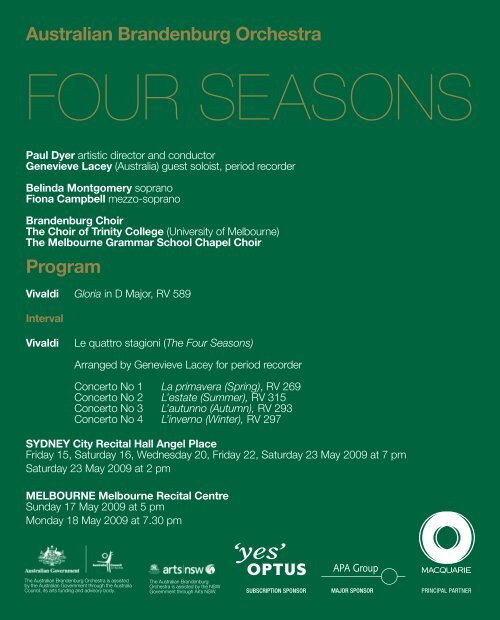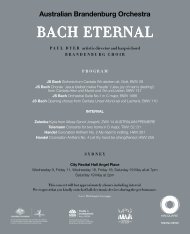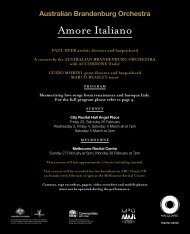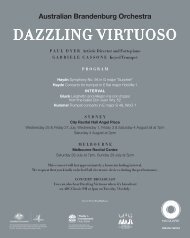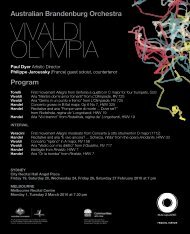download PDF program - Australian Brandenburg Orchestra
download PDF program - Australian Brandenburg Orchestra
download PDF program - Australian Brandenburg Orchestra
You also want an ePaper? Increase the reach of your titles
YUMPU automatically turns print PDFs into web optimized ePapers that Google loves.
<strong>Australian</strong> <strong>Brandenburg</strong> <strong>Orchestra</strong><br />
FOUR SEASONS<br />
Paul Dyer artistic director and conductor<br />
Genevieve Lacey (Australia) guest soloist, period recorder<br />
Belinda Montgomery soprano<br />
Fiona Campbell mezzo-soprano<br />
<strong>Brandenburg</strong> Choir<br />
The Choir of Trinity College (University of Melbourne)<br />
The Melbourne Grammar School Chapel Choir<br />
Program<br />
Vivaldi Gloria in D Major, RV 589<br />
Interval<br />
Vivaldi<br />
Le quattro stagioni (The Four Seasons)<br />
Arranged by Genevieve Lacey for period recorder<br />
Concerto No 1 La primavera (Spring), RV 269<br />
Concerto No 2 L’estate (Summer), RV 315<br />
Concerto No 3 L’autunno (Autumn), RV 293<br />
Concerto No 4 L’inverno (Winter), RV 297<br />
SYDNEY City Recital Hall Angel Place<br />
Friday 15, Saturday 16, Wednesday 20, Friday 22, Saturday 23 May 2009 at 7 pm<br />
Saturday 23 May 2009 at 2 pm<br />
MELBOURNE Melbourne Recital Centre<br />
Sunday 17 May 2009 at 5 pm<br />
Monday 18 May 2009 at 7.30 pm<br />
The <strong>Australian</strong> <strong>Brandenburg</strong> <strong>Orchestra</strong> is assisted<br />
by the <strong>Australian</strong> Government through the Australia<br />
Council, its arts funding and advisory body.<br />
The <strong>Australian</strong> <strong>Brandenburg</strong><br />
<strong>Orchestra</strong> is assisted by the NSW<br />
Government through Arts NSW.<br />
SUBSCRIPTION SPONSOR<br />
1
Antonio Vivaldi<br />
(1678–1741)<br />
Gloria in D Major, RV 589<br />
When an eighteenth-century visitor arrived at<br />
Vivaldi’s birthplace of Venice it must have felt like<br />
stepping into another, exotic world – or rather<br />
floating into it, as the city could then be reached only<br />
by being rowed there, across the lagoon from the<br />
mainland. Spread across one hundred and eighteen<br />
islands, Venice had been a major world power, but<br />
as its lagoon was too shallow for warships to enter,<br />
it had none of the gates or fortifications encountered<br />
in other European cities. Time was different there:<br />
the year began on the first of March, so a traveller<br />
might leave France or Germany in 1723 but find<br />
himself back in 1722 when he got to Venice. For the<br />
Venetians (along with most of Italy) the first hour of<br />
the day was the hour after the sun set – so midnight<br />
could be 4 o’clock, or 8 o’clock, depending on<br />
whether it was summer or winter. The use of the<br />
twenty-four hour clock would have bamboozled the<br />
unsuspecting foreigner even more.<br />
Once the visitor had got his head around the day<br />
and the time, and got used to canals and boats<br />
instead of streets and carriages, he also had to<br />
come to grips with the way Venetian society worked.<br />
This was particularly tricky if he had expected to<br />
have any dealings with the upper class, as Venetian<br />
nobility were forbidden on pain of death to visit<br />
or even speak to foreigners because of fears of<br />
espionage. The French man of letters Charles de<br />
Brosses, who visited Venice in 1739 wrote: “This<br />
is in no way a mere threat, and one noble has<br />
been put to death simply for having walked past<br />
an ambassador’s house”. Luckily, the nobility were<br />
permitted to dress only in black, which would have<br />
made them easier to spot. The Venetian custom<br />
of wearing masks in public at all times – initially<br />
done just during Carnival before the start of Lent<br />
but extended to about six months of the year –<br />
added to the foreigner’s confusion as it resulted in a<br />
relaxation of the rules of polite behaviour, especially<br />
for women. The famous libertine Casanova<br />
explained, “You can see the nobility mingling with<br />
the people, the prince with the subject, the rare with<br />
the ordinary, the beautiful with the horrible. There are<br />
no longer any magistrates or laws in operation.”<br />
This lax behaviour extended to church going.<br />
A German visitor wrote in 1730: “Few people<br />
observe the externals of religion more than the<br />
Italians do, especially the Venetians. It can be said<br />
of them that they spend half of their life in doing<br />
wrong and the other half in asking God to forgive<br />
them for it.” Churches were places of entertainment,<br />
to meet friends, and to keep assignations. A secret<br />
agent of the Venetian state reported in 1711:<br />
I humbly inform you that for a long time recently<br />
the church of San Salvatore has become the<br />
object of profanation, on feast days, by a great<br />
number of women of all types, who, instead<br />
of going there to hear Holy Mass, come to be<br />
admired and courted. I have heard many devout<br />
people say that the church of San Salvatore has<br />
become a brothel.<br />
The best church music could be heard at St Mark’s<br />
Basilica and at the chapels attached to the four<br />
ospedali, charitable institutions which cared for<br />
orphans, children of the destitute, and the diseased<br />
or otherwise infirm. One, the Pio Ospedale della<br />
Pietà, had a niche in its wall where new-born babies<br />
could be left, rather like the afterhours chute at a<br />
library. When the boys reached adolescence they<br />
were placed in apprenticeships, but girls had to be<br />
protected from the outside world, and they needed<br />
a dowry in order to marry or to become nuns.<br />
Most earnt their dowries through crafts such as<br />
lacemaking, but another course was possible for<br />
those girls who were musically talented, and that<br />
was to join the all-female orchestras and choirs<br />
which each ospedale maintained. They performed<br />
to celebrate the glory of God, not for their own<br />
fulfilment, and had to agree never to perform in<br />
public anywhere else. Yet the girls were taught by<br />
the best musicians in Italy, among them Farinelli’s<br />
singing teacher Nicola Porpora, and the violinists<br />
Tartini, Gasparini, and Vivaldi, who was sometime<br />
music director at the Pietà. All composed music<br />
especially for them. A number of the girls became<br />
renowned virtuosi, and many lived their whole lives<br />
at the ospedali, performing and teaching.<br />
In addition to their very high standard of<br />
performance, the pure exoticism of hearing women<br />
and girls perform in an age when court and theatre
orchestras and conventional church choirs were<br />
made up entirely of men and boys, made the<br />
ospedali a tourist attraction no visitor to Venice<br />
wanted to miss. An English traveller wrote in 1722:<br />
Every Sunday and holiday there is a performance<br />
of music in the chapels of these hospitals<br />
[ospedali], vocal and instrumental, performed<br />
by the young women of the place, who are set<br />
in a gallery above and, though not professed<br />
[i.e. not nuns], are hid from any distinct view of<br />
those below by a lattice of ironwork. The organ<br />
parts, as well as those of the other instruments<br />
are all performed by the young women. ... Their<br />
performance is surprisingly good ... and this is<br />
all the more amusing since their persons are<br />
concealed from view.<br />
Although the experience could be mesmerising<br />
(Rousseau commented after hearing them, “I cannot<br />
imagine anything so voluptuous, so touching as this<br />
music”), foreign visitors complained that the Masses<br />
at the ospedali more closely resembled a concert<br />
than a church service, and they were particularly<br />
scandalised when the congregation turned their<br />
chairs to face the musicians rather than the altar in<br />
the middle of the service. “You go there to listen to<br />
the concert, like going to the opera house”, sniffed<br />
the Frenchman Comte de Caylus who visited Venice<br />
in 1715, and indeed tickets were sold to the Masses<br />
as though they were concerts.<br />
Vivaldi wrote a significant amount of sacred vocal<br />
music for the Pietà, including two settings of the<br />
Gloria, RV 588 and RV 589. Both settings are<br />
thought to have been composed about the same<br />
time, in the mid 1710s, just a few years before he<br />
wrote The Four Seasons. The second setting has<br />
become one of the best loved of all choral works<br />
and this is the one which we hear tonight.<br />
Despite its popularity, we know nothing about the<br />
circumstances of the Gloria’s composition. It is<br />
scored for string orchestra, solo trumpet and oboe,<br />
with soprano and alto solos, and voices in the usual<br />
four parts – soprano, alto, tenor and bass. In the<br />
first performances given at the Pietà, all parts and<br />
instruments would have been performed by women<br />
only. It would have been thought scandalous to<br />
bring men in from outside to augment the choir,<br />
and the male teachers never performed with them.<br />
Nevertheless, the tenor and bass parts were<br />
probably sung at the notated pitch, which would<br />
have given the choral sound a very different tone<br />
colour to the one we are used to hearing. There<br />
are some women who are capable of singing much<br />
lower than the usual female range, covering the<br />
same pitches as a baritone, but the sound would be<br />
quite soft. To accommodate this, Vivaldi set the bass<br />
part in the Gloria relatively high, and kindly doubled<br />
the voices with low strings when a lower note is<br />
necessary for the harmony. In modern performances<br />
the tenor and bass parts are sung by men.<br />
The Gloria is one of the most important sung<br />
expressions of praise in the Christian tradition and<br />
is used in Protestant and Orthodox services, as well<br />
as Roman Catholic, where it forms part of the Mass<br />
except during Advent and Lent. Its first words are<br />
those sung by the angels announcing the birth of<br />
Christ as told in the Gospel according to Luke in the<br />
New Testament, and the remaining verses date from<br />
the fourth century. As a priest, Vivaldi would have<br />
been well aware of the importance of the text, but it<br />
is the force of his personality expressed through the<br />
music that makes the work so memorable, rather<br />
than the detail of the word setting. The opening bars<br />
contain a Vivaldi trademark – string instruments<br />
playing in unison and quickly alternating between an<br />
upper and lower octave. This simple device has an<br />
almost visceral effect, and the congregation hearing<br />
it at the Pietà for the first time would have found it<br />
thrilling and awe-inspiring.
1. Chorus<br />
Gloria in excelsis Deo<br />
2. Chorus<br />
Et in terra pax<br />
hominibus bone voluntatis.<br />
3. Duet<br />
Laudamus te, benedicimus te, adoramus<br />
te, glorificamus te.<br />
4. Chorus<br />
Gratias agimus tibi<br />
5. Chorus<br />
Propter magnam gloriam tuam.<br />
6. Aria - Soprano<br />
Domine Deus, Rex caelestis,<br />
Deus Pater omnipotens.<br />
7. Chorus<br />
Domine Fili unigenite, Jesu Christe.<br />
8. Aria and chorus<br />
Domine Deus, agnus Dei, Filius Patris.<br />
Qui tollis peccata mundi,<br />
miserere nobis.<br />
9. Chorus<br />
Qui tollis peccata mundi,<br />
suscipe deprecationem nostram.<br />
10. Aria<br />
Qui sedes ad dexteram Patris,<br />
miserere nobis.<br />
11. Chorus<br />
Quoniam tu solus sanctus,<br />
tu solus Dominus,<br />
tu solus altissimus,<br />
Jesu Christe.<br />
12. Chorus<br />
Cum Sancto Spiritu<br />
in glori Dei Patris.<br />
Amen.<br />
Glory be to God on high<br />
And on earth peace<br />
to people of good will.<br />
We praise you, we bless you,<br />
we adore you, we glorify you.<br />
We give thanks<br />
For your great glory.<br />
Lord God, king of heaven,<br />
God the Father almighty.<br />
Lord Jesus Christ, the only begotten son.<br />
Lord God, lamb of God, Son of the Father.<br />
You who takes away the sins of the world,<br />
have mercy on us.<br />
You who takes away the sins of the world,<br />
receive our prayer.<br />
You who sits at the right hand of the Father,<br />
have mercy on us.<br />
For you only are holy,<br />
you only are the Lord,<br />
you only are the most high,<br />
Jesus Christ.<br />
With the Holy Spirit<br />
in the glory of God the Father.<br />
Amen.
Le quattro stagioni (The Four Seasons)<br />
from Opus 8: Il cimento dell’armonia<br />
e dell’inventione (The contest between<br />
harmony and invention), arranged by<br />
Genevieve Lacey for solo recorder<br />
and string orchestra<br />
Concerto No 1 La primavera (Spring) RV 269<br />
Concerto No 2 L’estate (Summer) RV 315<br />
Concerto No 3 L’autunno (Autumn) RV 293<br />
Concerto No 4 L’inverno (Winter) RV 297<br />
TO THE MOST ILLUSTRIOUS LORD<br />
Lord Wenzel Count von Morzin, Hereditary<br />
Lord of Hohen Elbe, Lomnitz, Tschista, Krzinetz,<br />
Kaunitz, Doubek, and Sowoluska, Current<br />
Chamberlain and Counsellor of His Caesarian<br />
and Catholic Majesty<br />
BY DON ANTONIO VIVALDI<br />
Maestro in Italy of the Most Illustrious Aforementioned<br />
Lord Count, Concert Master of the Pio Ospedale della<br />
Pietà in Venice, and Director of Chamber Music to<br />
His Most Serene Highness Prince Philip, Landgrave<br />
of Hesse-Darmstadt.<br />
Pray do not be surprised if, among these few and<br />
feeble concertos, Your Most Illustrious Lordship<br />
finds the Four Seasons which have so long enjoyed<br />
the indulgence of Your Most Illustrious Lordship’s<br />
kind generosity, but believe that I have considered<br />
it fitting to print them because, while they may<br />
be the same, I have added to them, besides the<br />
sonnets, a very clear statement of all the things that<br />
unfold in them, so that I am sure that they will appear<br />
new to you. … The supreme understanding of music<br />
which Your Most Illustrious Lordship possesses<br />
and the merit of your most accomplished orchestra<br />
will always allow me to live in the certainty that my<br />
humble efforts, having reached your esteemed<br />
hands, will enjoy that eminence which they do not<br />
deserve… Therefore, nothing remains for me but<br />
to beseech Your Most Illustrious Lordship to<br />
continue your most generous patronage and never<br />
deprive me of the honour of owning myself to be<br />
YOUR MOST ILLUSTRIOUS LORDSHIP’S<br />
Most Humble, Most Devoted, Most Obliged Servant<br />
ANTONIO VIVALDI<br />
Dedication of first publication of The Four Seasons<br />
The Four Seasons, along with eight other concertos,<br />
were published in 1725 as part of Vivaldi’s Opus 8,<br />
however, he had actually composed them some<br />
time earlier, probably around 1718–20. Athough<br />
the 1725 volume is dedicated to Count von Morzin,<br />
it is not known for whom they were originally<br />
composed, but as this was a period of Vivaldi’s<br />
life when he was absent from Venice it seems<br />
certain that they were not for the girls at the Pietà.<br />
The concertos were instantly popular, particularly<br />
in France: the first concerto, La primavera (Spring),<br />
was played for Louis XV at Versailles and it was the<br />
favourite showcase piece for the greatest French<br />
and Italian violinists of the time.<br />
Astonishing as it may seem today, interest in<br />
Vivaldi’s works died with him in 1743 and<br />
The Four Seasons concertos were forgotten<br />
until the Vivaldi revival in the early decades of the<br />
twentieth century. They are now among the most<br />
popular pieces of classical music in the world<br />
and well over four hundred recordings have been<br />
made of the concertos. Their popularity peaked<br />
towards the end of the 1980s when new<br />
recordings averaged nineteen a year.<br />
While composers both before and since have<br />
attempted to describe the changes of the<br />
seasons in music, Vivaldi achieves this in<br />
astonishingly vivid and original detail, from<br />
a barking dog on a sleepy spring afternoon<br />
to the chattering of teeth on a freezing winter’s<br />
day. The concertos are a tour de force in the<br />
composition of representational music, that is,<br />
music which depicts scenes or sounds, most<br />
often those found in nature (known also as<br />
“<strong>program</strong>me music”).<br />
But Vivaldi was not just writing music that was<br />
purely descriptive: he was conforming to the<br />
baroque aesthetic that said that music should<br />
“not only please the ear, but … strike the<br />
Imagination, affect the Mind, and command the<br />
Passions”. So we hear the barking dog but also<br />
feel the loneliness of its owner, we hear the fury<br />
of the north wind but shudder at its potential for<br />
destruction, and we hear the steady drip of a cold<br />
winter rain but enjoy the cosiness of being inside<br />
by the fire.
Vivaldi was not content to leave the interpretation<br />
of the concertos to the listener’s imagination,<br />
indeed quite the contrary. When the concertos<br />
were first published a sonnet entitled Sonetto<br />
Dimostrativo (literally ‘Demonstrative Sonnet’) was<br />
printed at the beginning of each concerto. The<br />
sonnets, probably written either by Vivaldi himself<br />
or one of his opera librettists, narrate the changing<br />
aspects of the seasons and each one consists<br />
of three main ideas which are reflected by the<br />
three movements of each concerto. Vivaldi clearly<br />
marked the scores to indicate which musical<br />
passages represent which verse, or in some places<br />
which line, of the sonnet. In the dedication at the<br />
front of the first edition of The Four Seasons he<br />
wrote “I have added to them, besides the sonnets,<br />
a very clear statement of all the things that unfold<br />
in them” by means of captions throughout the<br />
score. In the first movement of Summer, for<br />
example, the calls of the cuckoo, the turtledove<br />
and the finch are all captioned, as is the famous<br />
barking dog represented by the viola in the same<br />
movement. The events and sounds indicated in the<br />
captions are not always to be found in the sonnets,<br />
which has caused some commentators to speculate<br />
that Vivaldi did not write the music to illustrate the<br />
sonnets, but rather the other way around.<br />
Vivaldi’s method of delivering both description and<br />
emotional content is brilliantly simple: in the fast<br />
movements he uses recurring ritornellos (refrains)<br />
played by the full orchestra which provide the<br />
scene or backdrop, while individual, transient<br />
events or sounds are portrayed in short musical<br />
episodes, usually by the solo violin, replaced in<br />
these performances by solo recorder. The first<br />
movement of Spring, for example, begins with<br />
a joyful dance which returns throughout the<br />
movement, punctuated by the sounds of bird<br />
song, a flowing stream, and lightning and thunder.<br />
The slow movements by contrast are more like<br />
static tableaux, although painted with considerable<br />
detail. In the second movement of Spring we “see”<br />
only the shepherd asleep in the meadow but hear<br />
the rustle of the trees above.<br />
From a historical perspective replacing the violin<br />
with a recorder is particularly apposite. The recorder<br />
had been popular in Venice as a solo instrument<br />
since the Renaissance, but there was relatively<br />
little music composed specifically for it and players<br />
often adapted pieces intended for violin. There<br />
was a resurgence of interest in it among Venetian<br />
composers in the early eighteenth century led by<br />
Vivaldi, who composed many works for recorder<br />
or flute and used these instruments in virtuosic<br />
ways that were then very new.<br />
It was common in the Baroque period for<br />
composers to re-present their musical ideas with<br />
different instruments, with the resultant change in<br />
musical textures and timbres often giving the work<br />
an entirely new feel. Played on the recorder, the<br />
solo episodes stand out against the orchestral<br />
string texture, and the instrument’s soft, gentle<br />
sound is particularly effective in the purely<br />
representational moments such as the bird calls<br />
in Spring.<br />
The texts of the sonnets are printed below, with<br />
Vivaldi’s additional captions indicated in the places<br />
where they appear in the score by italics and<br />
square brackets.<br />
Concerto No 1 in E major, La primavera (Spring), RV 269<br />
I Allegro<br />
Giunt’ è la Primavera e festosetti<br />
[Il canto de gl’ucelli]<br />
La salutan gl’Augei con lieto canto,<br />
[Scorrono i fonti]<br />
E i fonti allo spirar de’ zeffiretti<br />
Con dolce mormorio scorrono intanto:<br />
[Tuoni]<br />
Vengon’ coprendo l’aer di nero amanto<br />
E lampi, e tuoni ad annuntiarla eletti<br />
[Canto d’ucelli]<br />
Indi tacendo questi, gl’Augelletti;<br />
Tornan’ di nuovo al lor canoro incanto:<br />
Spring has arrived and festively<br />
[The song of the birds]<br />
the birds salute her with happy song;<br />
[The fountains flow]<br />
and the fountains at the breath of the breezes<br />
with a sweet murmur continually flow;<br />
[Thunder]<br />
coming to cover the sky with a black mantle<br />
are lightning and thunder, chosen to announce her,<br />
[Song of the birds]<br />
then when they are silent, the little birds<br />
return anew to their tuneful songs.
II Largo<br />
[Mormorio di fronde e piante]<br />
[Il cane che grida]<br />
[Il capraro che dorme]<br />
E quindi sul fiorito ameno prato<br />
Al caro mormorio di fronde e piante<br />
Dorme ’l Caprar col fido can’ à lato.<br />
III Allegro<br />
[Danza pastorale]<br />
Di pastoral Zampogna al suon festante<br />
Danzan Ninfe e Pastor nel tetto amato<br />
Di primavera all’ apparir brillante.<br />
[Murmurs of branches and leaves – a direction to<br />
the first and second violins]<br />
[The dog barks – Vivaldi directs the viola: “this must<br />
be played very loudly and raspingly throughout”]<br />
[The goat-herd sleeps – a direction to the solo<br />
violin/recorder]<br />
And later in the pleasant flowery meadow,<br />
to the welcome murmurs of branches and leaves,<br />
the goat-herd sleeps with his faithful dog beside him.<br />
[Pastoral dance]<br />
To the festive sound of rustic bagpipes,<br />
nymphs and shepherds dance beneath the lovely canopy<br />
of brilliant spring.<br />
Concerto No 2 in G minor, L’estate (Summer), RV 315<br />
I Allegro non molto<br />
[Languidezza per il caldo]<br />
Sotto dura staggion dal sole accesa<br />
Langue l’huom, langue ’l gregge, ed arde il Pino;<br />
[Il cucco]<br />
Scioglie il Cucco la Voce,<br />
[La tortorella]<br />
e tosto intesa canta la Tortorella e ’l gardelino.<br />
[Il gardellino]<br />
[Zeffiretti dolci]<br />
Zeffiro dolce spira,<br />
[Vento Borea]<br />
[Venti impettuosi]<br />
[Venti diversi]<br />
mà contesa<br />
muove Borea improviso al suo vicino;<br />
[Il pianto del villanello]<br />
E piange il Pastorel, perche sospesa<br />
Teme fiera borasca, e ’l suo destino;<br />
II Adagio<br />
[Mosche e mossoni]<br />
Toglie alle membra lasse il suo riposo<br />
Il timore de’ Lampi, e tuoni fieri<br />
E de mosche, e mossoni il stuol furioso!<br />
[Tuoni]<br />
III Presto<br />
[Tempo impettuoso d’estate]<br />
Ah che pur troppo i suoi timor son veri,<br />
Tuona e fulmina il Ciel e grandinoso<br />
Tronca il capo alle spiche e a’ grani alteri.<br />
[Languor due to the heat]<br />
Beneath the harsh season of blazing sun<br />
man languishes, flocks languish, and pines are scorched;<br />
[The cuckoo]<br />
the cuckoo raises its voice,<br />
[The turtle dove]<br />
and immediately the turtle dove and the finch sing.<br />
[The finch]<br />
[Soft breezes]<br />
The soft breeze sighs,<br />
[North wind – solo violin/recorder]<br />
[Impetuous winds – violas]<br />
[Diverse winds – basso continuo]<br />
but is suddenly challenged<br />
by the north wind moving into its vicinity;<br />
[The tears of the shepherd boy]<br />
and the shepherd weeps, because he fears<br />
the fierce looming storm and his destiny.<br />
[Flies and blowflies – tutti violins]<br />
Depriving his weary limbs of rest are<br />
the fear of lightning and fierce thunder,<br />
and the furious swarm of flies and blowflies!<br />
[Thunder]<br />
[Stormy summer weather]<br />
Ah, how true his worst fears are,<br />
as the heavens thunder and flash, and hailstones<br />
strike the heads from the stalks of the ripe grain.
Concerto No 3 in F major, L’autunno (Autumn), RV 293<br />
I Allegro – Allegro assai<br />
[Ballo e canto de’ vilanelli]<br />
Celebra il Vilanel con balli e Canti<br />
Del felice raccolto il bel piacere<br />
[L’ubriaco / ubriachi]<br />
E del liquor de Bacco accesi tanti<br />
[L’ubriaco che dorme]<br />
Finiscono col sonno il lor godere<br />
II Adagio molto<br />
[Ubriachi dormienti]<br />
Fà ch’ ogn’uno tralasci e balli e canti<br />
L’aria che temperata dà piacere,<br />
E la Staggion ch’invita tanti e tanti<br />
D’un dolcissimo sonno al bel godere.<br />
III Allegro<br />
[La caccia]<br />
I cacciator alla nov’alba à caccia<br />
Con corni, schioppi, e canni escono fuore<br />
[La fiera che fugge]<br />
Fugge la belva, e seguono la traccia;<br />
[Schioppi, e cani]<br />
Già sbigottita, e lassa al gran rumore<br />
De’ schioppi e canni, ferita minaccia<br />
[La fiera fuggendo muore]<br />
Languida di fuggir, mà oppressa muore.<br />
[Dance and song of the villagers]<br />
The peasant celebrates with dances and songs<br />
the pleasures of a good harvest<br />
[The drunkard / drunkards – solo violin and continuo]<br />
and many, fired by Bacchus’ liquor,<br />
[The drunkard who sleeps]<br />
end their enjoyment in sleep.<br />
[Sleeping drunkards]<br />
The mild, pleasant air makes everyone<br />
abandon songs and dances,<br />
and the season invites all and sundry<br />
to the delight of sweetest sleep.<br />
[The hunt]<br />
The hunters set out on the chase at first light<br />
with horns, guns and dogs<br />
[The quarry flees]<br />
the beast flees, and they follow its track;<br />
[Guns and dogs]<br />
already bewildered, and distracted by the great noise<br />
of guns and dogs, wounded, it attempts<br />
[The quarry, fleeing, dies]<br />
feebly to escape, but exhausted, dies.<br />
Concerto No 4 in F minor, L’inverno (Winter), RV 297<br />
I Allegro non molto<br />
Aggiacciato tremar trà neri algenti<br />
[Orrido vento]<br />
Al severo spirar d’orrido Vento,<br />
[Correre, e batter li piedi per il freddo]<br />
Correr battendo i piedi ogni momento;<br />
[Venti]<br />
[Batter li denti]<br />
E pel soverchio gel batter i denti;<br />
II Largo<br />
[La pioggia]<br />
Passar al foco i di quieti e contenti<br />
Mentre la pioggia fuor bagna ben cento<br />
III Allegro<br />
Caminar sopra ’l giaccio,<br />
[Caminar piano, e con timore]<br />
e à passo lento per timor di cader gersene intenti;<br />
Gir forte sdruzziolar, cader à terra<br />
[Cader a terra]<br />
[Correr forte]<br />
Di nuove ir sopra ’l giaccio e correr forte<br />
Sin ch’il giaccio si rompe, e si disserra;<br />
[Il vento sirocco]<br />
Sentir uscir dalle ferrate porte<br />
[Il vento borea e tutti li venti]<br />
Sirocco, Borea, e tutti i Venti in guerra<br />
Quest’ è ’l verno, mà tal, che gioia apporte.<br />
Program notes © Lynne Murray 2009<br />
Frozen, shivering amid icy snows<br />
[Dreadful wind]<br />
At the cutting breath of the dreadful wind,<br />
[Running and stamping the feet in the cold]<br />
to run stamping one’s feet at every moment;<br />
[Winds]<br />
[Chattering teeth]<br />
and the overwhelming frost causing teeth to chatter;<br />
[Rain – pizzicato violins]<br />
To pass quiet and contented days by the fire<br />
while the rain outside drenches a hundred others;<br />
To walk on the ice<br />
[Walking slowly and cautiously]<br />
and with slow steps tread cautiously for fear of falling;<br />
To go fast, slip, fall to the ground;<br />
[Falling on the ground]<br />
[Running fast]<br />
to go onto the ice again and run fast<br />
until the ice cracks and breaks;<br />
[The sirocco wind]<br />
To hear as they emerge through the iron gates<br />
[The north wind and all the winds]<br />
Sirocco, Boreas, and all the winds at war;<br />
this is winter, which nonetheless brings its own delights.


